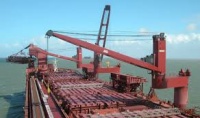Difference between revisions of "Dry Bulk Terminal Systems"
PurplePen19 (talk | contribs) |
|||
| Line 7: | Line 7: | ||
* Please start editing this page after the /noinclude | * Please start editing this page after the /noinclude | ||
* -------------------------------------------------></noinclude> | * -------------------------------------------------></noinclude> | ||
[[File:Dry Bulk Terminal Systems_1.jpg|thumb|200px|right|Dry Bulk Terminal Systems]] | |||
'''Dry Bulk Terminal Systems''' are sometimes called as Dry Bulk Handling Systems and is commonly used in constructions and transportations. | |||
The increasing need for bulk terminal extension offers a perfect chance to adopt latest developments in terminal design and technology. The application of discrete event simulation in a modern design approach as well as new developments in maintenance and dust and sound emission control should be considered. | |||
Due to the high demand for energy and mineral resources many dry bulk terminals around the world are expanding and seriously increasing their capacity. One approach to expansion can simply be copying the existing facilities until the required capacity is reached. In this way however the terminal does not only loose the opportunity to utilize the developments made over the last decades on terminal design, it will also end up with a costly operation. In addition it may not be able to reach the environmental restrictions imposed on terminal operations nearby environmentally sensitive areas. | |||
==Types and Applications== | |||
===For Cement=== | |||
This turn-key supply included the design, foundation work, flat storage and all other buildings, ship unloader, mobile blow pump unit, conveying system, front end loaders, bagging station, power generator and automatic control systems. | |||
===For Coal=== | |||
A suitable example is the design, manufacture and delivery of major equipment for our installation in the port of Keelung, Taiwan, which included a ship unloader, a portal type stacker/-reclaimer, a belt scale system, a bucket elevator, magnetic separators, vibrating feeders and loading spouts for truck loading stations. Further included was supervision for the mechanical and electrical erection as well as commissioning and start-up. | |||
==Videos== | |||
<youtube>VXS13qRTssg</youtube> | |||
Latest revision as of 05:31, 8 September 2013
Dry Bulk Terminal Systems are sometimes called as Dry Bulk Handling Systems and is commonly used in constructions and transportations.
The increasing need for bulk terminal extension offers a perfect chance to adopt latest developments in terminal design and technology. The application of discrete event simulation in a modern design approach as well as new developments in maintenance and dust and sound emission control should be considered.
Due to the high demand for energy and mineral resources many dry bulk terminals around the world are expanding and seriously increasing their capacity. One approach to expansion can simply be copying the existing facilities until the required capacity is reached. In this way however the terminal does not only loose the opportunity to utilize the developments made over the last decades on terminal design, it will also end up with a costly operation. In addition it may not be able to reach the environmental restrictions imposed on terminal operations nearby environmentally sensitive areas.
Types and Applications
For Cement
This turn-key supply included the design, foundation work, flat storage and all other buildings, ship unloader, mobile blow pump unit, conveying system, front end loaders, bagging station, power generator and automatic control systems.
For Coal
A suitable example is the design, manufacture and delivery of major equipment for our installation in the port of Keelung, Taiwan, which included a ship unloader, a portal type stacker/-reclaimer, a belt scale system, a bucket elevator, magnetic separators, vibrating feeders and loading spouts for truck loading stations. Further included was supervision for the mechanical and electrical erection as well as commissioning and start-up.
Videos
